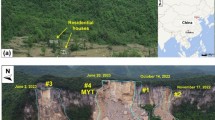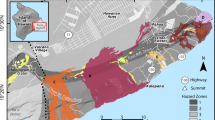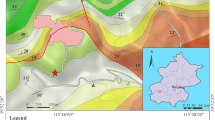Abstract—
The Oxia Planum region has been chosen as the landing site for the future ESA ExoMars 2022 rover for both scientific value and engineering safety (Ivanov et al., 2020). The main goal of this work is the identification and measurement of boulders located over different areas of the Oxia Planum landing region to understand the generation/degradation processes that occurred over the studied area. For the boulders manual identification and counting, we use different HiRISE images and we calculate their size-frequency distribution and spatial density. The data are well-fitted with power-law and exponential curves with shallower indices in the Amazonian units, ranging from –4.03 to –4.74 for the power-law fit and from –1.43 to –1.80 for the exponential fit, while steeper indices in the three exhumed Noachian units studied (from –5.20 to ‒5.57 for the power-law fit and from –1.77 to –2.13 for the exponential fit). As previously studied in the former Oxia Planum landing centre (Pajola et al., 2017), the formation of boulders in this area is related to impact processes: the Amazonian unit is between 2.4 to 48.2 times richer of boulders than the exhumed Noachian units. By comparing these results with other boulder distributions, identified on other Oxia exhumed Noachian locations, we obtain a smaller boulder spatial density. We also compare our results with those derived from other Martian landing sites, finding that, for instance, the new centre location of the ExoMars ellipse is 4.5 times less dangerous than the Pathfinder landing site. The boulder analysis is of fundamental importance from an engineering perspective, returning the safest areas where the ExoMars 2022 rover might land and traverse.












Similar content being viewed by others
Notes
Scarp ledges can be avoided because they have elongated shapes that are contiguous and different to those of the isolated boulders.
REFERENCES
Aboudan, A., Pacifici, A., Murana, A., et al., Automatic rocks detection and classification on high resolution images of planetary surfaces, in 45th Lunar and Planetary Science Conf., 2014, p. 1705.
Ahrens, T.J. and Johnson, M.L., Shock wave data for rocks, Rock Physics and Phase Relations: A Handbook of Physical Constants, New York: Wiley, 1995, vol. 3, pp. 35–44.
Ai, H. and Ahrens, T.J., Dynamic tensile strength of terrestrial rocks and application to impact cratering, Meteorit. Planet. Sci., 2004, vol. 39, no. 2, pp. 233–246.
Bart, G.D. and Melosh, H.J., Distributions of boulders ejected from lunar craters, Icarus, 2010, vol. 209, no. 2, pp. 337–357.
Bibring, J.P., Soufflot, A., Berthé, M., et al., OMEGA: Observatoire pour la Minéralogie, l’Eau, les Glaces et l’Activité, in Mars Express: The Scientific Payload, ESA SP-1240, Noordwijk, Netherlands: ESA Publications Division, 2004, pp. 37–49.
Binder, A.B., Arvidson, R.E., Guinness, E.A., et al., The geology of the Viking Lander 1 site, J. Geophys. Res., 1977, vol. 82, no. 28, pp. 4439–4451.
Bourke, M.C., Brearley, A.J., Haas, R., et al., The surface features of ‘pristine’ flood-transported boulders, in Lunar and Planetary Science Conf. XXXVI, 2005, p. 2253.
Carter, J., Quantin, C., Thollot, P., et al., Oxia Planum: A clay-laden landing site proposed for the ExoMars rover mission: Aqueous mineralogy and alteration scenarios, 47th Lunar and Planetary Science Conf., 2016, p. 2064.
Cheng, Y., Johnson, A.E., Mattheis, L.H., et al., Passive imaging based hazard avoidance for spacecraft safe landing, in 6th Int. Symposium on Artificial Intelligence, Robotics and Automation in Space, Montreal, Canada, 2001, id. 20060031528.
Chevrier, V.F. and Mathé, P.-E., Mineralogy and evolution of the surface of Mars: A review, Planet. Space Sci., 2007, vol. 55, pp. 289–314.
Christensen, P.R., The spatial distribution of rocks on Mars, Icarus, 1986a, vol. 68, no. 2, pp. 217–238.
Christensen, P.R., Regional dust deposits on Mars: Physical properties, age, and history, J. Geophys. Res., 1986b, vol. 91, no. B3, pp. 3533–3545.
Christensen, P.R., Jakosky, B.M., Kieffer, H.H., et al., The thermal emission imaging system (THEMIS) for the Mars 2001 Odyssey mission, Space Sci. Rev., 2004, pp. 85–130.
Craddock, R.A., Golombek, M., and Howard, A.D., Analyses of rock size-frequency distributions and morphometry of modified Hawaiian lava flows: Implications for future Martian landing sites, in Lunar and Planetary Science and Exploration Conf., 2000, id. 20000081248.
DellaGiustina, D.N., Emery, J.P., Golish, D.R., et al., Properties of rubble-pile asteroid (101955) Bennu from OSIRIS-REx imaging and thermal analysis, Nat. Astron., 2019, vol. 3, pp. 341–351.
Garvin, J.B., Mouginis-Mark, P.J., and Head, J.W., Characterization of rock populations on planetary surfaces: Techniques and a preliminary analysis of Mars and Venus, Moon Planets, 1981, vol. 24, no. 3, pp. 355–387.
Geissler, P., Petit, J.-M., Durda, D.D., et al., Erosion and ejecta reaccretion on 243 Ida and its moon, Icarus, 1996, vol. 120, no. 1, pp. 140–157.
Golombek, M. and Rapp, D., Size-frequency distributions of rocks on Mars and Earth analog sites: Implications for future landed missions, J. Geophys. Res., 1997, vol. 102, no. E2, pp. 4117–4129.
Golombek, M.P., Haldemann, A.F.C., Forsberg-Taylor, N.K., et al., Rock size-frequency distributions on Mars and implications for Mars Exploration Rover landing safety and operations, J. Geophys. Res., 2003a, vol. 108, no. E12, pp. 27:1–27:23.
Golombek, M.P., Grant, J.A., Parker, T.J., et al., Selection of the Mars Exploration Rover landing sites, J. Geophys. Res., 2003b, vol. 108, no. E12, pp. 13:1–13:48.
Golombek, M.P., Huertas, A., Marlow, J., et al., Size-frequency distributions of rocks on the northern plains of Mars with special reference to Phoenix landing surfaces, J. Geophys. Res., 2008, vol. 113, no. E3, E00A09, pp. 1–32.
Golombek, M.P., Huertas, A. Kipp, D., et al., Detection and characterization of rocks and rock size-frequency distributions at the final four Mars Science Laboratory landing sites, Mars, 2012, vol. 7, pp. 1–22.
Grant, J.A., Wilson, S.A., Ruff, S.W., et al., Distribution of rocks on the Gusev Plains and on Husband Hill, Mars, Geophys. Res. Lett., 2006, vol. 33, id. L16202, pp. 1–6.
Hamilton, V.E. and Ruff, S.W., Distribution and characteristics of Adirondack-class basalt as observed by Mini-TES in Gusev crater, Mars and its possible volcanic source, Icarus, 2012, vol. 218, no. 2, pp. 917–949.
Hausrath, E.M., Navarre-Sitchler, A.K., Sak, P.B., et al., Basalt weathering rates on Earth and the duration of liquid water on the plains of Gusev Crater, Mars, Geology, 2008, vol. 36, pp. 67–70.
Hébrard, E., Listowski, C., Coll, P., et al., An aerodynamic roughness length map derived from extended Martian rock abundance data, J. Geophys. Res. Atmos., 2012, vol. 117, id. E04008, pp. 1–26.
Huertas, A., Cheng, Y., and Madison, R., Passive imaging based multi-cue hazard detection for spacecraft safe landing, IEEE Aerospace Conf., 2006, id. 20060044143.
Ivanov, M.A., Slyuta, E.N., Grishakina, E. A., et al., Geomorphological Analysis of ExoMars candidate landing site Oxia Planum, Sol. Syst. Res., 2020, vol. 54, no. 1, pp. 1–17.
Jaeger, J.G., Cook, N.G.W., and Zimmerman, R., Fundamentals of Rock Mechanics, Hoboken, N.J.: Blackwell, 2007.
Kuiper, G.P., The surface structure of the Moon, in The Nature of the Lunar Surface: Proc. 1965 IAU-NASA Symp., 1965, pp. 99–105.
Kueppers, M., Moissl, R., Vincent, J.-B., et al., Boulders on Lutetia, Planet. Space Sci., 2012, pp. 71–78.
Lee, S.W., Thomas, P., and Veverka, J., Phobos, Deimos, and the Moon: Size and distribution of crater ejecta blocks, Icarus, 1986, vol. 68, no. 1, pp. 77–86.
Malin, M.C., Bell J.F. III, Cantor, B.A., et al., Context camera investigation on board the Mars Reconnaissance Orbiter, J. Geophys. Res., 2007, vol. 112, id. E05S04, pp. 1–25.
Matthies, L., Huertas, A., Cheng, Y., et al., Landing hazard detection with stereo vision and shadow analysis, 17th Annual American Astronautical Society Infotech, 2007, pp. 1–10.
Mazrouei, S., Daly, M.G., Barnouin, O.S., et al., Block distributions on Itokawa, Icarus, 2014, vol. 229, pp. 181–189.
McEwen, A.S., Eliason, E.M., Bergstrom, J.W., et al., Mars Reconnaissance Orbiter’s High Resolution Imaging Science Experiment (HiRISE), J. Geophys. Res., 2007, vol. 112, no. E5, id. E05S02, pp. 1–40.
Melosh, H.J., Impact ejection, spallation, and the origin of meteorites, Icarus, 1984, vol. 59, no. 2, pp. 234–260.
Melosh, H.J., Impact cratering: A geologic process, Earth Sci. Rev., 1989, vol. 41, nos. 3–4, pp. 222–224.
Michikami, T., Nakamura, A.M., Hirata, N., et al., Size-frequency statistics of boulders on global surface of asteroid 25143 Itokawa, Earth Planets Space, 2008, vol. 60, no. 1, pp. 13–20.
Michikami, T., Honda, C., Miyamoto, H., et al., Boulder size and shape distributions on asteroid Ryugu, Icarus, 2019, vol. 331, pp. 179–191.
Morris, R.V., Golden, D.C., Bell, J.F. III, et al., Mineralogy, composition, and alteration of Mars Pathfinder rocks and soils: Evidence from multispectral, elemental, and magnetic data on terrestrial analogue, SNC meteorite, and Pathfinder samples, J. Geophys. Res. Atmos., 2000, vol. 105, no. E1, pp. 1757–1817.
Murchie, S.L., Arvidson, R.E., Bedini, P., et al., CRISM (Compact Reconnaissance Imaging Spectrometer for Mars) on MRO (Mars Reconnaissance Orbiter), Proc. SPIE: Instruments, Science, and Methods for Geospace and Planetary Remote Sensing, 2004, vol. 5660, pp. 66–77.
Mutch, T.A., Binder, A.B., Huck, F.O., et al., The surface of Mars: The view from the Viking 1 lander, Science, 1976a, vol. 193, no. 4255, pp. 791–801.
Mutch, T.A., Grenander, S.U., Jones, K.L., et al., The surface of Mars: The view from the Viking 2 lander, Science, 1976b, vol. 194, no. 4271, pp. 1277–1283.
Nowicki, S.A. and Christensen, P.R., Rock abundance on Mars from the thermal emission spectrometer, J. Geophys. Res., 2007, vol. 112, no. E5, id. E05007, pp. 1–20.
Osinski, G.R., Tornabene, L.L., and Grieve, R.A.F., Impact ejecta emplacement on terrestrial planets, Earth and Planet. Sci. Lett., 2011, vol. 310, pp. 167–181.
Pajola, M., Vincent, J.-B., Guettler, C., et al., Size-frequency distribution of boulders \( \geqslant \)7 m on comet 67P/Churyumov-Gerasimenko, Astron. Astrophys., 2015, vol. 583, art. no. A37, pp. 1–17.
Pajola, M., Lucchetti, A., Bertini, I., et al., Size-frequency distribution of boulders \( \geqslant \)10 m on comet 103P/Hartley 2, Astron. Astrophys., 2016a, vol. 585, A85, pp. 1–8.
Pajola, M., Rossato, S., Baratti, E., et al., The Simud–Tiu Valles hydrologic system: A multidisciplinary study of a possible site for future Mars on-site exploration, Icarus, 2016b, vol. 268, pp. 355–381.
Pajola, M., Rossato, S., Baratti, E., et al., Boulder abundances and size-frequency distributions on Oxia Planum-Mars: Scientific implications for the 2020 ESA ExoMars rover, Icarus, 2017, vol. 296, pp. 73–90.
Pajola, M., Rossato, S., Baratti, E., et al., Planetary mapping for landing sites selection: The Mars case study, Planetary Cartography and GIS, Berlin: Springer, 2019, pp. 175–190.
Putzig, N.E., Mellon, M.T., Kretke, K.A., et al., Global thermal inertia and surface properties of mars from the MGS mapping mission, Icarus, 2005, vol. 173, no. 2, pp. 325–341.
Putzig, N.E. and Mellon, M.T., Apparent thermal inertia and the surface heterogeneity of Mars, Icarus, 2007, vol. 191, no. 1, pp. 68–94.
Quantin, C., Carter, J., Thollot, P., et al., Oxia Planum: A suitable landing site for ExoMars 2018 Rover, European Planetary Science Congress, 2015, vol. 10, id. EPSC2015-704.
Quantin, C., Carter, J., Thollot, P., et al., Oxia Planum, the landing site for ExoMars 2018, 47th Lunar and Planetary Science Conf., 2016, p. 2863.
Shoemaker, E.M., Preliminary analysis of the fine structure of the lunar surface in Mare Cognitum, The Nature of the Lunar Surface, Baltimore, Md.: Johns Hopkins, 1965, p. 23.
Smith, D.E., Zuber, M.T., Frey, H.V., et al., Mars Orbiter Laser Altimeter: Experiment summary after the first year of global mapping of Mars, J. Geophys. Res., 2001, vol. 106, no. E10, pp. 23689–23722.
Squyres, S.W., Arvidson, R.E., Bollen, D., et al., Overview of the Opportunity Mars Exploration Rover Mission to Meridiani Planum: Eagle Crater to Purgatory Ripple, J. Geophys. Res. Planets, 2001, vol. 111, no. E12, id. E12S12, pp. 1–19.
Stolper, E.M., Baker, M.B., Newcombe, M.E., et al., The petrochemistry of Jake\(\_\)M: A Martian mugearite, Science, 2013, vol. 341, no. 6153, pp. 1239463:1–7.
Surveyor scientific evaluation and analysis team, size distribution of debris on lunar surface and characteristics of fine matrix, in Lunar Surface Topography, Surveyor 1 Mission Report, Washington, DC: Natl. Aeronaut. Space Admin., 1966, pp. 31–32.
Tanaka, K.L., Skinner, J.A., Dohm, J.M., et al., Geologic Map of Mars, Reston, Va.: US Geological Survey, 2014.
Thomas, P.C., Veverka, J., Robinson, M.S., et al., Shoemaker crater as the source of most ejecta blocks on the asteroid 433 Eros, Nature, 2001, vol. 413, pp. 394–396.
Viles, H.A., Brearley, J.A., Bourke, M.C., et al., What processes have shaped basalt boulders on Earth and Mars? Studies of feature persistence using facet mapping and fractal analysis, 36th Annual Lunar and Planetary Science Conf., League City, Tex., 2005, p. 2237.
Yingst, Haldemann, A.F.C., Biedermann, K.L., et al., Quantitative morphology of rocks at the Mars Pathfinder landing site, J. Geophys. Res., 2007, vol. 112, no. E6, id. E06002, pp. 1–21.
Yesavage, T., Thompson, A, Hausrath, E.M., et al., Basalt weathering in an Arctic Mars-analog site, Icarus, 2015, vol. 254, pp. 219–232.
ACKNOWLEDGMENTS
We thank the anonymous referee for a fast and constructive review of the paper. This study has been supported by the Italian Space Agency (ASI-INAF agreement no. 2017-03-17). The NASA PDS Cartography and Imaging Science Node, as well as the USGS Astrogeology Science Center PILOT Node are acknowledged for providing access to the images used in this work.
Author information
Authors and Affiliations
Corresponding author
Ethics declarations
The authors declare no competing interests.
Rights and permissions
About this article
Cite this article
Mastropietro, M., Pajola, M., Cremonese, G. et al. Boulder Analysis on the Oxia Planum ExoMars 2022 Rover Landing Site: Scientific and Engineering Perspectives. Sol Syst Res 54, 504–519 (2020). https://doi.org/10.1134/S0038094620060040
Received:
Revised:
Accepted:
Published:
Issue Date:
DOI: https://doi.org/10.1134/S0038094620060040




